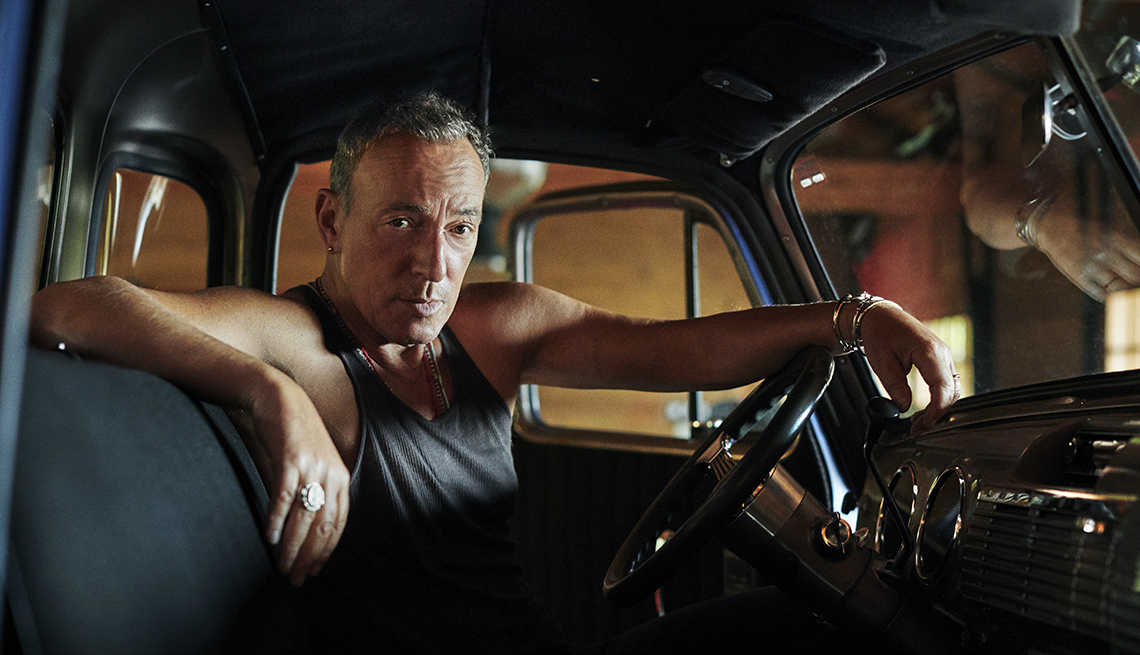Staying Fit
Part 1: The Gift
Bruce Springsteen, looking fit, tan and perfectly at ease in jeans and a T-shirt, greets me with an elbow bump as we sit down to talk on the porch of his New Jersey farmhouse. The view from here, a rolling vista of 378 acres of beautiful horse country, is perhaps the most visible reward for his lifetime of hard work and outsize success as a rock musician and writer. But it's still a working farm. The busy recording studio is just down the hill, and the 100-year-old barn is a multipurpose venue — the ground floor, home to his family's six horses; the hayloft, a place for local gatherings and even a bit of filmmaking.
Springsteen turned 71 in September, a freaky mile marker for many of us who have grown up with him. Though it shouldn't be close to shocking. We have been along for the ride through his many and varied lives: the ‘70s soul rocker and Boss of the mighty E Street Band, the pumped-up stadium showstopper, the writer of iconic, decade-defining songs like “Born to Run,” “Hungry Heart” and “The Rising.” And, more recently, the author of a critically acclaimed memoir, which he transmuted into a one-man show called Springsteen on Broadway. His directorial debut, a concert film for his 2019 album, Western Stars, whetted his appetite to direct again. Oh, and during this pandemic spring and summer, he seized the airwaves to try to raise our spirits and preach mask-wearing and patience ("stay strong, and stay home, and stay together") on his fortnightly radio show, From My Home to Yours, on Sirius XM.


AARP Membership— $12 for your first year when you sign up for Automatic Renewal
Get instant access to members-only products and hundreds of discounts, a free second membership, and a subscription to AARP the Magazine.
But I am here to talk to him about something quite remarkable for a musical artist of his vintage. His new record, Letter to You, an album of powerful, moving and elegiac rock music, takes up the great mysteries of life and death as only an earnest pilgrim of three-score-and-ten-plus-one could hope to pull off. With the full E Street Band — big drums, bass, lead guitars and keys — the record rocks, and it is age appropriate.


Letter to You is an album about carrying on in the face of loss. The loss of old friends such as George Theiss, who sang and played with a teenage Springsteen in his first band, the Castiles. The loss of two beloved E Street bandmates — organist Danny Federici and saxophonist Clarence Clemons; the passing of Springsteen's father; the slow decline of his mother due to Alzheimer's disease. The shedding of lives past, the passage of time itself — the preoccupations of all art that aims for greatness — are at the center of this work. It's a summing up, too, an offering from an old friend. But to whom is it addressed?
"Is it a letter to your younger self?” I ask. “Is it to your children? Your wife? Your fans? To me?"
Springsteen chuckles at the question: “It's to you! It's a letter to you! Whoever is listening. And, yeah, it is a summing up of what I've tried to do over the course of my 45, 50 years now, working."
The project began with a measure of self-doubt. “I hadn't written rock music for the E Street Band in about seven years,” he says. “I was thinking, Well, maybe I don't have any more rock music in me."
True, rock was in the Boss's rearview mirror for a while, as he embraced other musical styles, covered other writers’ songs, traveled wherever his muse set the GPS. For his previous record, Western Stars, the project was a visit to 1960s-era Los Angeles, to the days of Glen Campbell–style folk-pop with lush orchestration. Before that, he recorded and toured with a modern jug band of 17 or more musicians and a repertoire of traditional folk standards and spirituals made popular by Pete Seeger. And whoosh, just like that, seven years had passed, leaving Springsteen with nagging uncertainty: Could he still write great rock ‘n’ roll?
"You never really know,” he says. “It's part of the anxiety and mystery of the job that I do — which is a magic trick, because you take something out of the air that isn't there. There is no existence of it whatsoever, and you make it physical — literally. You can go for long periods without picking up anything significant. Or you'll just pick up different things. It's like you're in a mine and one vein has gone dry, so you tap into another. A pop vein or a folk vein, and so you start working there, and you discover a whole new rich vein of gold that you can draw from. It's not rock ‘n’ roll; it's just something else.
"But because I am primarily a rock ‘n’ roll musician when I'm operating sort of at my peak — in other words, in front of my largest audience with my favorite band — I like to … every once in a while, come up with some rock songs.”
Come up with some rock songs. … Ho ho ho. Just so you know, that last line, spun out to its understated to-do-list punch line by a virtuoso storyteller, was also delivered with a self-deprecating chuckle. Springsteen is funny in person. He's also fully present, generous with his attention and, to my surprise, as still as an Easter Island statue when he's not talking. I ask if we can avoid politics today. “Fine with me,” he says from the opposite end of a family-size table in front of this pretty fieldstone house. The day has brightened after a morning storm, and Bruce's wife of 29 years, Patti Scialfa, a tall redheaded singer-songwriter of considerable gifts herself, comes out to check on us — offering drinks and monitoring the social distance protocols at her home. Then the screen door closes, and she disappears back into the house.
Springsteen is the great empath of the rock world. He shows up for causes, big and small: hunger, poverty, Vietnam vets, 9/11 first responders, hurricane relief and many more, right down to Asbury Park local. But since our time today is not unlimited, I am very curious about how, after 50 years on the job, Springsteen still finds inspiration for his songwriting. He answers not as a rock star but as a member of a tribe, the humble representative of anyone who makes art for a living.
"You have your antenna out,” he says. “You're just walking through the world and you're picking up these signals of emotions and spirit and history and events, today's events and past remembrances. These things you divine from the air are all intangible elements: spirit, emotion, history. These are the tools of the songwriter's trade before he even picks up the pen.
"People who are very attuned to that atmosphere usually end up being artists of some sort. Because they're so attuned to it, they have a desire to record it. If that desire to record it is strong enough, you learn a language to do so. Whether it's paintings, films, songs, poetry …
"My antenna is picking up so much information, I need to find a way to disperse it. So, I needed to learn a language that does that. And the languages of art, film, records, whatever you want to call it — all those languages do that. And you get to pass it on to your listeners or fans. That's how it begins."






































































